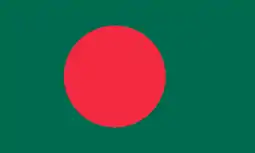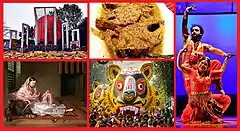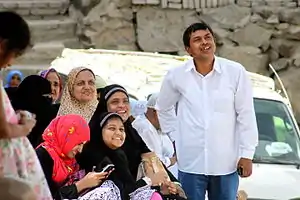Bangladeshi diaspora
The Bangladeshi diaspora consists of people of Bangladeshi descent who have immigrated to or were born in another country. First generation migrants may have moved abroad from Bangladesh for better living conditions, to escape poverty, to support their financial condition or to send money back to families in Bangladesh. Annual remittances received in Bangladesh were 18.20 billion dollars Fiscal Year 2019–2020.[21]
 | |
| Regions with significant populations | |
|---|---|
| 2,542,083 (2020)[1] | |
| 1,000,000 (2018)[2] | |
| 1,015,389 (2021)[3][4] | |
| 906,080 (2021)[5] | |
| 682,702 (2018)[6] | |
| 400,000 (2019)[7] | |
| 516,076 (2020)[8] | |
| 350,000 (2020)[9] | |
| 307,130 (2021)[10] | |
| 150,000 (2020)[11] | |
| 141,081 (2021)[12] | |
| 70,004 (2021)[13] | |
| 184,472 (2019)[14] | |
| 180,000 (2017)[15] | |
| 46,935 (2019)[16] | |
| 38,643 (2018)[17] | |
| 37,059 (2020)[18] | |
| 32,031 (2019)[18] | |
| 11,093 (2019)[18] | |
| 8,000[19] | |
| 8,000[20] | |
| Religion | |
| Predominantly Islam Substantial numbers follow Hinduism Smaller minorities follow Buddhism and Christianity | |
| Part of a series on |
| Bengalis |
|---|
 |
There is a large Bangladeshi diaspora population in Saudi Arabia, where there are around 2.3 million.[22] There are also significant migrant communities in various Arab states of the Persian Gulf, particularly the United Arab Emirates and Kuwait, where Bangladeshis are mainly classified as foreign workers. The United Kingdom's 2001 census found 300,000 (500,000 in 2009 census) British Bangladeshi mainly concentrated in east London boroughs (Tower Hamlets and Newham); the migration to Britain is mainly linked with chain migration from the Sylhet Division (95% of the UK-Bangladeshi population are from the Sylhet Division who are also regarded as Sylheti diaspora). Besides the UK and Middle East, Bangladeshis also have a significant presence in the United States, mainly in New York City (where many are also from Sylhet, Chittagong, and other regions) and Paterson in New Jersey, in East and Southeast Asian countries such as Malaysia, South Korea and Japan, and in other Western countries such as Italy, Canada, and Australia.
West Asia

Bangladeshis in the Middle East form the largest part of the worldwide Bangladeshi diaspora. Approximately 4,600,000 live within the Middle East, with around half of them in Saudi Arabia, and 15% of them in Oman.
Saudi Arabia
Saudi Arabia has over two million Bangladeshis, making it the largest Bangladeshi diaspora community. Bangladesh is one of the largest labour suppliers to Saudi Arabia, in 2007 Bangladeshi workers obtained the biggest share, with 23.50 per cent of the 1.5 million Saudi Arabia visas issued. There are around 3 Bangladeshi schools in Saudi Arabia in Riyadh,Jeddah and Dammam.
United Arab Emirates
There are 706,000 Bangladeshis residing in the United Arab Emirates as of 2020. There is one Bangladeshi school in UAE called Shaikh Khalifa Bin Zayed Bangladesh Islamia School in Abu Dhabi. Bangladeshis make up around 7% of the UAE population and are 4th largest community in the UAE.
Bahrain
Bahrain has about 180,000 Bangladeshis as of 2017.
Oman
Oman has about 682,702 Bangladeshis as of 2018. There is one Bangladeshi school in Oman called Bangladesh School Muscat in Muscat.
Kuwait
Kuwait has about 350,000 Bangladeshis as of 2020.
Qatar
Qatar has about 400,000 Bangladeshis as of 2019. There is one Bangladeshi school in Doha called Bangladesh MHM School & College.Bangladeshis in Qatar make more than 14% of the Qatar population.
Southern and Eastern Asia
Maldives
According to the Maldivian foreign ministry; some 50,000 Bangladeshi were working in there in 2011, a nation of only around 400,000 people, with a third having no valid documents or registration.[23]
Malaysia
The Bangladeshi population in Malaysia is 1,000,000 as of 2018.
South Korea
In South Korea, there are more than 13,000 Bangladeshi foreign workers in the country. A few of them include illegal immigrants. The 2009 Korean film Bandhobi, directed by Sin Dong-il, depicts a Bangladeshi migrant in South Korea.[24][25]
Japan
Bangladeshis in Japan (在日バングラデシュ人, Zainichi Banguradeshujin) form one of the smaller populations of foreigners in Japan. As of 2005, Japan's Ministry of Justice recorded 11,055 Bangladeshi nationals among the total population of registered foreigners in Japan.[16]
Western world
United Kingdom
The British Bangladeshi community is one of the largest immigrant communities in the United Kingdom, and is well established in many parts of the UK, most notably London, mainly in the East London boroughs, of which the Tower Hamlets has the highest percentage of Bangladeshis with about 33% of the borough's total population. Other boroughs include Newham, where 12% of the boroughs population is Bangladeshi.In the 2011 Census 451,529 UK residents specified their ethnicity as Bangladeshi, forming 0.7% of the total population.There is also a significant community in and around Westminster. About half live in London, with a heavy concentration in Tower Hamlets borough of East London.[38] The UK is also the third single largest export destination for Bangladesh[39].Based on the 2011 census, 52% of Bangladeshis were British-born, while 48% were born outside of the UK of which 212,000 were born in Bangladesh.[46] In the same year, there was a slightly larger male than female population, with 52% male and 48% female.Most Bangladeshis in the UK come from the Sylhet Region in Bangladesh.As majority of British Bangladeshis originate from the Sylhet region, the most common language variety spoken is Sylheti with about 400,000 speakers.[79] Sylheti is generally considered as a dialect of Bengali, though others may view it as a separate language.[80][81][82][83] In the context of diglossia, in Bangladesh Sylheti is in a low status viewed as a regional dialect while standard Bengali (the official language) has a high status.[84] In the UK however, Sylheti being used as the main vernacular by a majority uninfluenced by standard Bengali has led some to view it as a distinct language.[85] There had even been attempts during the 1980s to establish Sylheti language classes in London contending to Bengali language classes.[86] Some British linguists are attempting to revive a script that was historically used in the Sylhet region called Sylheti Nagri.[87] In 2017, British schools enlisted Sylheti in the list of native languages spoken by students.[88] Nevertheless, many Sylheti speakers say they speak Bengali due to not expecting outsiders to be well informed about dialects.[89] The Sylheti dialect is the third most spoken language in London, after English and Polish.

Standard Bengali is spoken at home by a sizeable minority of British Bangladeshis. It is largely spoken by the recent Italian Bangladeshi migrants, as most originate from the Dhaka region.[90] Italian is also spoken by this particular community.[91] Maintaining its prominence in British Bangladeshi media, standard Bengali is considered as a prestige language which helps to foster a cultural or national identity linked with Bangladesh,[92] parents therefore encourage young people to attend Bengali classes to learn the language.[58] Although many Sylheti speakers find this learning progress difficult in the UK.[76][93]
Based on the 2011 census, English is spoken as a main language by nearly half of the population.[94] While those who considered Bengali or Sylheti as their main language, more than half (70%) were proficient in speaking English.[95] English tends to be spoken among the younger generation, and Bengali/Sylheti with the older generation.[96]
Majority of the Bangladeshi population are Sunni Muslim;[98] a small minority follow other religions. In London, Bangladeshi Muslims make up 24% of all London Muslims, more than any other single ethnic group in the capital.
96.7% of British Bangladeshis live in England the population being 436,514.
Ofsted reports from secondary schools have shown that many Bangladeshi pupils are making significant progress, compared with other ethnic minority groups.[57] Girls are more likely to do better in education than boys; 55% of girls are achieving 5 or more A*-C at GCSE, compared to 41% boys, as of 2004. The overall achievement rate for Bangladeshi pupils was 48%, compared with 53% for all UK pupils, in 2004.[58] By 2013, the British Bangladeshi achievement rate (5 or more A*-C at GCSE) had increased considerably to 61%, compared to 56% for White British students and 51% for British Pakistani students.[59] It was reported in 2014, there were a total of 60,699 graduates of Bangladeshi descent.[60] In November 2015, an Institute for Fiscal Studies (IFS) report said that Bangladeshi children living in the UK have a nearly 49 percent higher chance on average of a university education than white British pupils.[61]
95% of all Indian restaurants are run by Bangladeshis.[71] The curry industry employs over 150,000 people, contributes £4.5 billion to the economy each year[54][182][183] and is viewed as recognition of Bangladeshi success, through awards such as 'The British Curry Awards'.[184][185] Brick Lane, known as Banglatown, is home to many of these restaurants, and is now regarded as London's 'curry capital', with thousands of visitors every day.[186] The restaurants serve different types of curry dishes, including fish, chutneys, and other halal dishes.[187] Attitudes towards restaurant work has shifted among second-generation Bangladeshis who lack interest in working in the curry industry due to their social mobility and opportunities provided by their parents.[182] As of 2016, according to the Bangladesh High Commission, Brick Lane has 57 Bangladeshi-owned curry houses, and in England as a whole, around 90% of all curry houses are owned by British Bangladeshis.[62]
Since 2012/13, it is estimated that around 20,000 Italian Bangladeshis had settled in the UK, according to the Bangladeshi Italian Welfare Association (based on figures provided by the Embassy of Italy, London).[51] Majority had settled within the long-established Bangladeshi community in East London. Many were skilled graduates who left their homes in South Asia attracted by jobs in Italy's industrial north, but moved to the UK when Italian manufacturing jobs went into decline.[52]
Outside London, the Bangladeshi diaspora lies in areas such as Birmingham, with a population over 35,000 Bangladeshis, Sandwell with over 7,000 residents, specifically wards such as St Pauls., Tipton, and West Bromwich, Oldham, with over 15,000, Luton, with over 13,000, and Bradford with over 10,000, and Manchester, with over 10,000 British Bangladeshis. Other smaller populations include Portsmouth with over 6,000, Sunderland and Newcastle upon Tyne with over 3,000 people each, Bedford with over 3,200, St Albans with 2,200, Leeds with 4,500, and Leicester with 3,500. The British Bangladeshi has grown drastically, and has grown from 283,000 residents (according to the 2001 UK Census), to 451,000 residents (according to the 2011 UK Census) of Bangladeshi descent.
Mass migration started since the days of the British Raj, where lascars from Sylhet were often sent to the United Kingdom. Some of these lascars lived in the United Kingdom in port cities, and even married British women. Since then, mass migration has occurred, specifically from Sylhet.
The street of Brick Lane in East London, has a large history of Bangladeshis and has officially been dubbed as "Banglatown", and has hundreds of "Indian" restaurants nearly all owned by Sylheti Bangladeshis. Many British Bangladeshis have made their presence in the UK, often becoming doctors, engineers, and lawyers, but also many have become politicians for the Labour and Conservative Parties, such as Rushanara Ali, and Tulip Siddiq, as well as London Borough Mayors, such as Lutfur Rahman and Nasim Ali.
United States
The census in 2000, found up to 95,300 were born in Bangladesh, therefore it is estimated there are at least 150,000 Bangladeshis in the United States. It was until the 1990s when Bangladeshis, many from Dhaka, Chittagong, and Sylhet, started to move to the United States, and settled in urban areas such as New York, Paterson in New Jersey, Philadelphia, Atlantic City, New Jersey and Washington D.C.. Although recent findings claim that Bangladeshis started arriving during the late 19th centuries from the southern part of current Bangladesh. In some parts of Queens and Manhattan in New York City, there are Bangladeshi restaurant owners of Bangladeshi, Indian, and Pakistani restaurants. The Baishakhi Mela celebration of the Bengali New Year is also held by the Bangladeshi American communities in New York, Paterson, Philadelphia, Washington, D.C., Atlantic Cityand other cities annually. The street of 3rd Street, Los Angeles has a large history of Bangladeshis and has officially been dubbed as "Little Bangladesh". However, some Bangladeshis residing in New York have settled in newer areas, such as Hamtramck, Michigan, Buffalo, New York, Paterson, New Jersey, and many other nearby states due to lower living costs and better job opportunities. Many Bangladeshis in New York City are often Taxi Drivers, Fast-Food Chain Workers, Restaurant Workers, software developer, computer scientists, medical doctors, attorneys, accountants, business owners etc. In Atlantic City many work in casinos.
Italy
Bangladeshis are one of the largest immigrant populations in Italy. As of 2016, there were 126,000 Bangladeshis living in Italy. Most of the Bangladeshis in Italy are based in Lazio, Lombardy and Veneto with large concentrations in Rome, Milan and Venice.
Canada
Bangladeshi Canadian refers to a person of Bangladeshi background born in Canada or a Bangladeshi that has migrated to Canada. Before 1971 about 150 Bengali people came to Canada as East Pakistani. The main influx of migration of Bangladeshis started early 80's. Back in 1988, about 700 Bangladeshi families lived in Toronto, though about another 900 families were living in Montreal. Now, Toronto has a sizeable Bangladeshi community much larger than Montreal's with over 50,000 in the city proper and over 65,000 in the Greater Toronto Area. Toronto's eastern districts of East York and Scarborough on Danforth Avenue has a large Bangladeshi population. The area around Danforth has many Bangla stores and restaurants. This area is known as Little Bangladesh. Through the Independent Category of Canadian immigration, huge numbers of Bangladeshis moved to Canada. Under the Investor Category, about 100 families moved to Canada since 2015. By 2020 June, it was estimated that around 90,000 Bangladeshi people live in Canada.
Australia
Bangladeshis in Australia are one of the smallest immigrant communities living in Australia. There are around 20,000 Bangladeshis in Australia. The largest Bangladeshi communities are mainly present in the states of New South Wales and Victoria, with large concentrations in the cities of Sydney and Melbourne.
See also
References
- "Asians in the Middle East" (PDF). Department of Economic and Social Affairs. United Nations.
- "Abuse of Bangladeshi Workers: Malaysian rights bodies for probe".
- "Resident Population Estimates by Ethnic Group, All Persons: All Persons; All Ages; Asian or Asian British: Bangladeshi (Persons)". Office for National Statistics. Archived from the original on 4 March 2016. Retrieved 10 March 2009.
- 2011 Census: Ethnic Group, local authorities in the United Kingdom, 11 October 2013, accessed 19 September 2016.
- "UNITED ARAB EMIRATES POPULATION STATISTICS (2020)". GLOBAL MEDIA INSIGHT. 7 July 2020. Retrieved 6 August 2020.
- "Bangladeshis top expatriate force in Oman". webindia123.com. 12 July 2018..
- "Population of Qatar by nationality - 2019 report". Priya Dsouza. 15 August 2019.
- "ASIAN ALONE OR IN ANY COMBINATION BY SELECTED GROUPS: 2015". U.S. Census Bureau. Archived from the original on 14 February 2020. Retrieved 15 October 2015.
- "Bangladeshi Workers: Around 2 lakh may have to leave Kuwait". The Daily Star. 15 July 2020.
- "Italy's Second Economy: The Impact of Bangladeshi Migration". Inter Press Service. 15 September 2016.
- "Bangladeshis in Singapore". High Commission of Bangladesh, Singapore. 15 February 2020.
- "Bangladeshi". Archived from the original on 19 August 2017. Retrieved 15 September 2016.
- Australian Beureau of Statistics. "People in Australia who were born in Bangladesh". Retrieved 6 August 2020.
- "Maldives to recruit Bangladeshi workers". Bangladesh News. 2 August 2008. Archived from the original on 20 June 2018. Retrieved 24 May 2010.
- "BMore illegal Bangladeshi workers enter Bahraini labor market". Xin Hua Net. 12 March 2017.
- Kitahara, Reiko; Otsuki, Toshio (22 March 2018). "A study on the living environment of Bangladeshi foreign residents in Kita‐ku, Tokyo: Influence on the concentrated area in a receiving country of migrant workers from chain migration based on international labor movement". Japan Architectural Review. Wiley Online Library. 1 (3): 371–384. doi:10.1002/2475-8876.12029.
- 체류외국인 국적별 현황, 2013년도 출입국통계연보, Ministry of Justice, 2013, p. 290, retrieved 5 June 2014
- "Bangladesh: Migrants fare badly in Italy". IRIN. 29 October 2010.
- http://www.qatar-tribune.com/news.aspx?n=659B1F3A-7299-4D4A-B2DA-D3BAA8AE673D&d=20150625%5B%5D
- https://www.dfa.ie/travel/travel-advice/a-z-list-of-countries/bangladesh/
- "Remittance flows 2015: Received: Bangladesh". Roxane Torre. April 2016. Retrieved 22 October 2017.
- "Bangladesh to send 2 million workers to Saudi Arabia". Newsnextbd.com. 5 February 2015. Archived from the original on 30 July 2015. Retrieved 8 May 2015.
- Nahar, K (2011) Maldives to deport thousands of illegal Bangladeshi workers, The Financial Express Pictorial, 13 June 2011, retrieved 8 July 2013,
Maldivian foreign minister Ahmed Naseem last week said some 50,000 Bangladeshi are now working in his country --- a nation of only around 400,000 people --- with one-third having no valid documents or registration.
- Bandhobi at IMDb
- Admissions as of 12 July 2009. "Bandhobi (Movie - 2009)". HanCinema. Retrieved on 5 August 2009.
